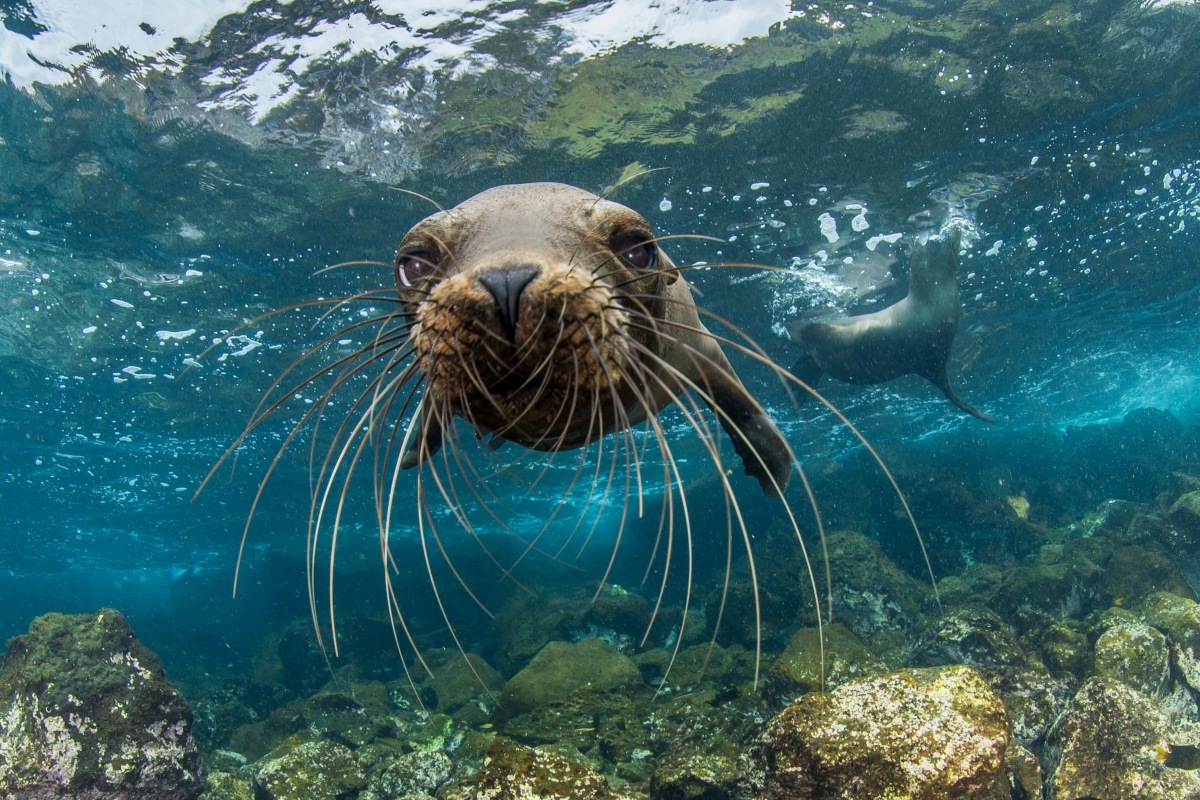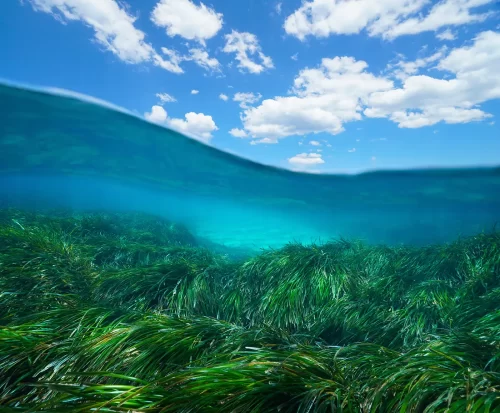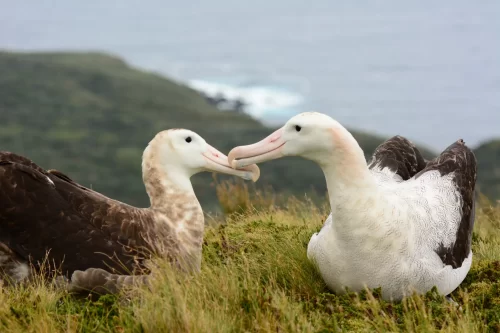Interactive, dynamic ocean data can help bolster effective conservation efforts
Covering more than 70 percent of our planet’s surface, the ocean is vital to all life on earth. It regulates global systems that make the world inhabitable for humankind—the air we breathe, the food we eat, even the patterns in weather we experience.
Yet the ocean, our life support system, is under threat from climate change, pollution and overfishing. Nearly two-thirds of the ocean is experiencing an increase in these human impacts. Marine protected areas, or MPAs, play a significant role in addressing these pressures. When implemented and managed properly, they can effectively protect critical habitats and species, helping to enhance biodiversity, stimulate fisheries, and safeguard the communities whose economies and traditions depend on a healthy, thriving ocean. In several studies, MPAs have also been credited with supporting climate change adaptation.
 A young Galapagos sea lion approaches Enric Sala’s camera off Santa Cruz Island. Inaugural partners using the portal include management authorities responsible for the iconic Galápagos Islands—one of the most biologically diverse MPAs in the world. © Pristine Seas / National Geographic.
A young Galapagos sea lion approaches Enric Sala’s camera off Santa Cruz Island. Inaugural partners using the portal include management authorities responsible for the iconic Galápagos Islands—one of the most biologically diverse MPAs in the world. © Pristine Seas / National Geographic.
Challenges in protecting the ocean
Today, less than 8 percent of the ocean is safeguarded through marine protected areas or other area-based conservation measures, with less than 3 percent covered by fully or highly-protected areas.
Despite legitimate efforts, many MPAs risk becoming what are commonly referred to as “paper parks”—lines on a map but offering little real protection in the water. Shortages in funding and limited capacity, coupled with vast areas to protect, often present insurmountable challenges when it comes to effectively managing MPAs.
A digital ocean
Effective marine protection is challenging—identifying sites for protection, and then monitoring these extensive ocean areas, takes huge resources that also rely on scientific data.
In the past, information about MPA science has often been proprietary and disconnected—this inhibits management and enforcement decisions. Failure to get data from those who produce it to those who use it often leads to lost opportunities to inform management decisions. Even when information is made readily available, it is often presented in visual formats that are static and not easily utilized or understood. And seldom does that information remain accessible or usable over a sustained period of time, reducing its impact on future policy decisions.
But with Global Fishing Watch Marine Manager, we now have an innovative technology portal that helps support the design, management and monitoring of existing and new MPAs and other area-based conservation measures. Providing near real-time, dynamic and interactive data on ocean conditions—from 2012 to three days ago—the portal provides managers and other registered users with access to high temporal resolution datasets, or data over discrete periods of time and space, across four categories: human activity, biological data, oceanographic data and maritime zones.
Founded by philanthropist and ocean advocate, Dona Bertarelli, the marine manager portal allows users to view Global Fishing Watch’s various datasets, such as fishing and shipping activity, alongside other information like sea surface temperature, ocean currents and habitat suitability. This gives managers an accurate picture of how protected areas can benefit from the ecosystems that surround them. The portal includes private collaboration workspaces for managers and researchers to upload their own data—biological, environmental or oceanographic—to support collaborations with the research community as well as share and analyze information that can help decision makers prioritize resources and target their efforts.
Pioneering technology to support marine protection
The ocean is far from static—dynamic ocean management requires dynamic ocean data. Global Fishing Watch Marine Manager combines biological and oceanographic data to provide stakeholders with the ability to conduct dynamic ocean analyses, encouraging leadership in marine protection and facilitating a better understanding of how human activity is impacting the ocean. The portal boasts three key functions that make this technology the first-of-its-kind.
- The portal layers information in an easy-to-use interface. The portal automatically collates information and compares environmental datasets with Global Fishing Watch’s fishing activity data. In the past, scientists and managers would have to extract data from a variety of sources and lay it on top of maps using geographic information systems, or GIS, technology. With Global Fishing Watch Marine Manager, the work is already done, making the information accessible and functional to various groups, including those that need to access data quickly to support science-based decisions.
- The portal allows users to upload private datasets. For the first time, managers and researchers can transfer their own layers of information into the portal and onto the map so they can create a comprehensive visualization alongside Global Fishing Watch’s datasets. This interactive function provides managers with the ability to add their own reference layer, animal tracks, or patrol vessel routes, and then view them all together or filter each layer to allow quick recognition of behavior.
- Global Fishing Watch Marine Manager creates time-series graphs using an experimental analysis function. This means managers are just a click away from viewing general fishing, shipping and environmental patterns in a selected area over a specific period of time. For example, managers can compare apparent fishing effort for any flag State operating in or around a specific site or marine protected area, allowing them to anticipate when fishing activity is likely to be at its peak and plan patrol trips accordingly. By combining this function with the ability to upload their own data, managers can focus in on specific areas of interest.
A global approach
International support is building to strengthen the protection of biodiversity and enhance resilience to the impacts of climate change through ocean action. Global Fishing Watch supports all governments that have committed to protecting marine resources, including those pledging to protect at least 30 percent of the ocean by 2030. However, protection targets must be informed by science to ensure effective and equitably managed, ecologically representative, well-connected systems of highly-protected areas and other effective area-based conservation measures. We believe the marine manager portal is perfectly placed to assist governments in these science-led efforts, and through our free-to-access platform we will enable ocean leaders to harness technology and open data, and protect our planet for future generations.
To kick-off this work, we have had the pleasure of engaging a range of partners from across the globe—all utilizing the portal for its various applications. From champions like Ascension Island and the Galápagos—both with established MPAs that seek to either protect endemic species or safeguard its thriving biodiversity—to Tristan da Cunha’s science-driven marine protection zone, the marine manager portal is serving a range of needs from enforcement to research.
We’ve also partnered with Niue whose primary objective is to better understand the impact of their MPA and increase their access to near real-time data. Niue is just one of many island nations in the South Pacific that have taken action to protect their vast waters. We hope that insight from the marine manager portal will help inform future decisions around new and existing MPAs throughout the region and help serve the needs of other island nations.
We’re also excited to be working with Guyana as it seeks to collect a baseline of environmental and human activity data that can be used to effectively protect their waters. The marine manager portal is helping them assess how oil and gas activity, and its associated noise pollution, will impact marine life.
Over the coming months, we will seek feedback and ideas from each site to assess the portal’s performance and build on their needs to make it as user-driven and as beneficial to them as possible.
Revolutionizing marine management
Global Fishing Watch Marine Manager is a significant addition to our platform’s suite of products, which are designed to drive change at a global scale. The portal can transform our ability to design, manage and monitor marine protected areas and other area-based conservation measures. Available to all and for free, it will help overcome many challenges, such as static or difficult-to-merge information, insufficient or unshared data, or simply a lack of resources to be able to procure cutting-edge technology. Such obstacles have hindered our ability to deliver the intended impacts that marine protected areas were envisaged to produce.
For the first time, scientists and managers are concurrently able to see human, biological and oceanographic data which, when overlaid with their own data, is enabling new insights and dynamic knowledge that can help inform their decisions.
While we’re starting small—just a handful of sites for now—the work is scalable and the opportunities endless. We look forward to seeing how Global Fishing Watch Marine Manager revolutionizes our approach to marine protection and helps facilitate strong leadership in the way we govern our ocean.
Tony Long is the chief executive officer of Global Fishing Watch.


